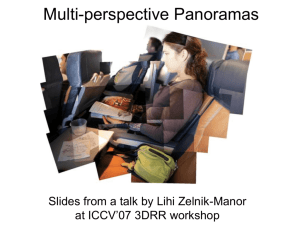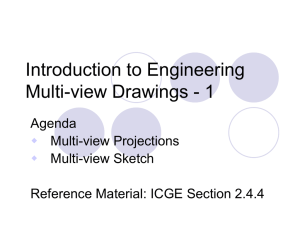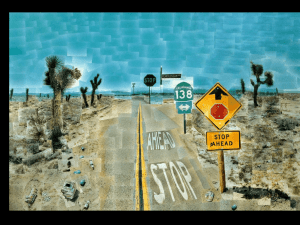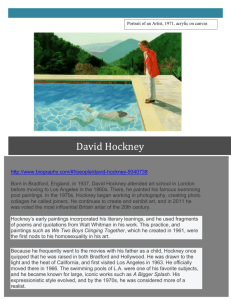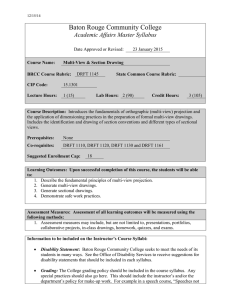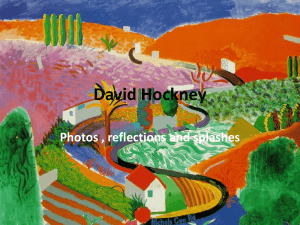Multi-perspective Panoramas Slides from a talk by Lihi Zelnik-Manor
advertisement
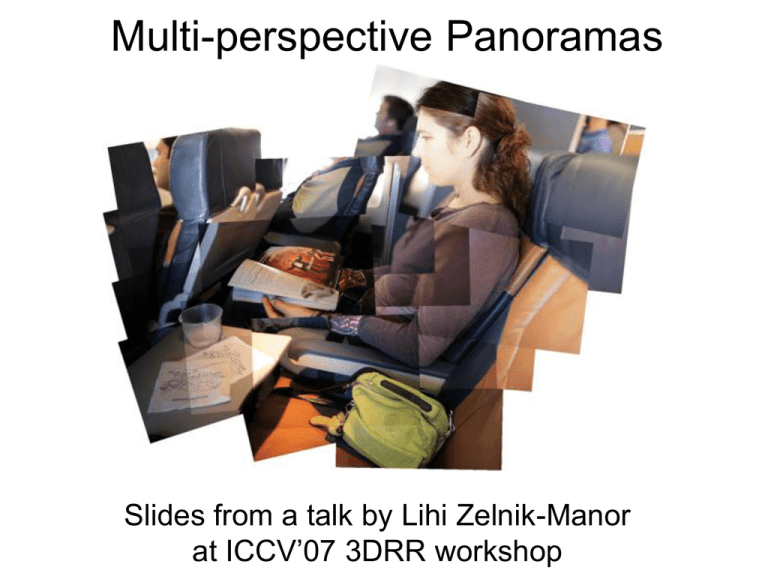
Multi-perspective Panoramas Slides from a talk by Lihi Zelnik-Manor at ICCV’07 3DRR workshop Objectives 1. Better looking panoramas 2. Let the camera move: • Any view • Natural photographing Stand on the shoulders of giants Cartographers Artists Cartographic projections Common panorama projections Perspective Stereographic φ Cylindircal θ Global Projections Perspective Cylindircal Stereographic Learn from the artists Sharp discontinuity Multiple view points perspective De Chirico “Mystery and Melancholy of a Street”, 1914 perspective Renaissance painters solution “School of Athens”, Raffaello Sanzio ~1510 Give a separate treatment to different parts of the scene!! Personalized projections “School of Athens”, Raffaello Sanzio ~1510 Give a separate treatment to different parts of the scene!! Multiple planes of projection Sharp discontinuities can often be well hidden Single view Our multi-view result Single view Our multi-view result Single view Our multi-view result Applying personalized projections Input images Foreground Background panorama Single view Our multi-view result Objectives - revisited 1. Better looking panoramas 2. Let the camera move: • Any view • Natural photographing Multiple views can live together Multi-view compositions David Hockney, Place Furstenberg, (1985) Why multi-view? Multiple viewpoints David Hockney, Place Furstenberg, 1985 Single viewpoint Melissa Slemin, Place Furstenberg, 2003 Long Imaging Agarwala et al. (SIGGRAPH 2006) Smooth Multi-View Google maps What’s wrong in the picture? Google maps Non-smooth Google maps The Chair David Hockney (1985) Joiners are popular Flickr statistics (Aug’07): 4,985 photos matching joiners. 4,007 photos matching Hockney. 41 groups about Hockney Thousands of members Main goals: Automate joiners Generalize panoramas to general image collections Objectives • For Artists: Reduce manual labor Manual: ~40min. Fully automatic Objectives • For Artists: Reduce manual labor • For non-artists: Generate pleasing-to-the-eye joiners Objectives • For Artists: Reduce manual labor • For non-artists: Generate pleasing-to-the-eye joiners • For data exploration: Organize images spatially What’s going on here? A cacti garden Principles Principles • Convey topology Correct Incorrect Principles • Convey topology • A 2D layering of images Blending: blurry Graph-cut: cuts hood Desired joiner Principles • Convey topology • A 2D layering of images • Don’t distort images translate rotate scale Principles • Convey topology • A 2D layering of images • Don’t distort images • Minimize inconsistencies Bad Good Algorithm Step 1: Feature matching Brown & Lowe, ICCV’03 Step 2: Align Large inconsistencies Brown & Lowe, ICCV’03 Step 3: Order Reduced inconsistencies Ordering images Try all orders: only for small datasets Ordering images Try all orders: only for small datasets complexity: (m+n) m = # images n = # overlaps = # acyclic orders Ordering images Observations: – Typically each image overlaps with only a few others – Many decisions can be taken locally Ordering images Approximate solution: – Solve for each image independently – Iterate over all images Can we do better? Step 4: Improve alignment Iterate Align-Order-Importance Iterative refinement Initial Final Iterative refinement Initial Final Iterative refinement Initial Final What is this? That’s me reading Anza-Borrego Tractor Art reproduction Paolo Uccello, 1436 Art reproduction Paolo Uccello, 1436 Zelnik & Perona, 2006 Art reproduction Single view-point Zelnik & Perona, 2006 Manual by Photographer Our automatic result Failure? GUI The Impossible Bridge Homage to David Hockney Take home • Incorrect geometries are possible and fun! • Geometry is not enough, we need scene analysis • A highly related work: "Scene Collages and Flexible Camera Arrays,” Y. Nomura, L. Zhang and S.K. Nayar, Eurographics Symposium on Rendering, Jun, 2007. Thank You 15-463 Class Project from 2007 http://www.cs.cmu.edu/afs/andrew/scs/cs/1 5-463/f07/proj_final/www/echuangs/
